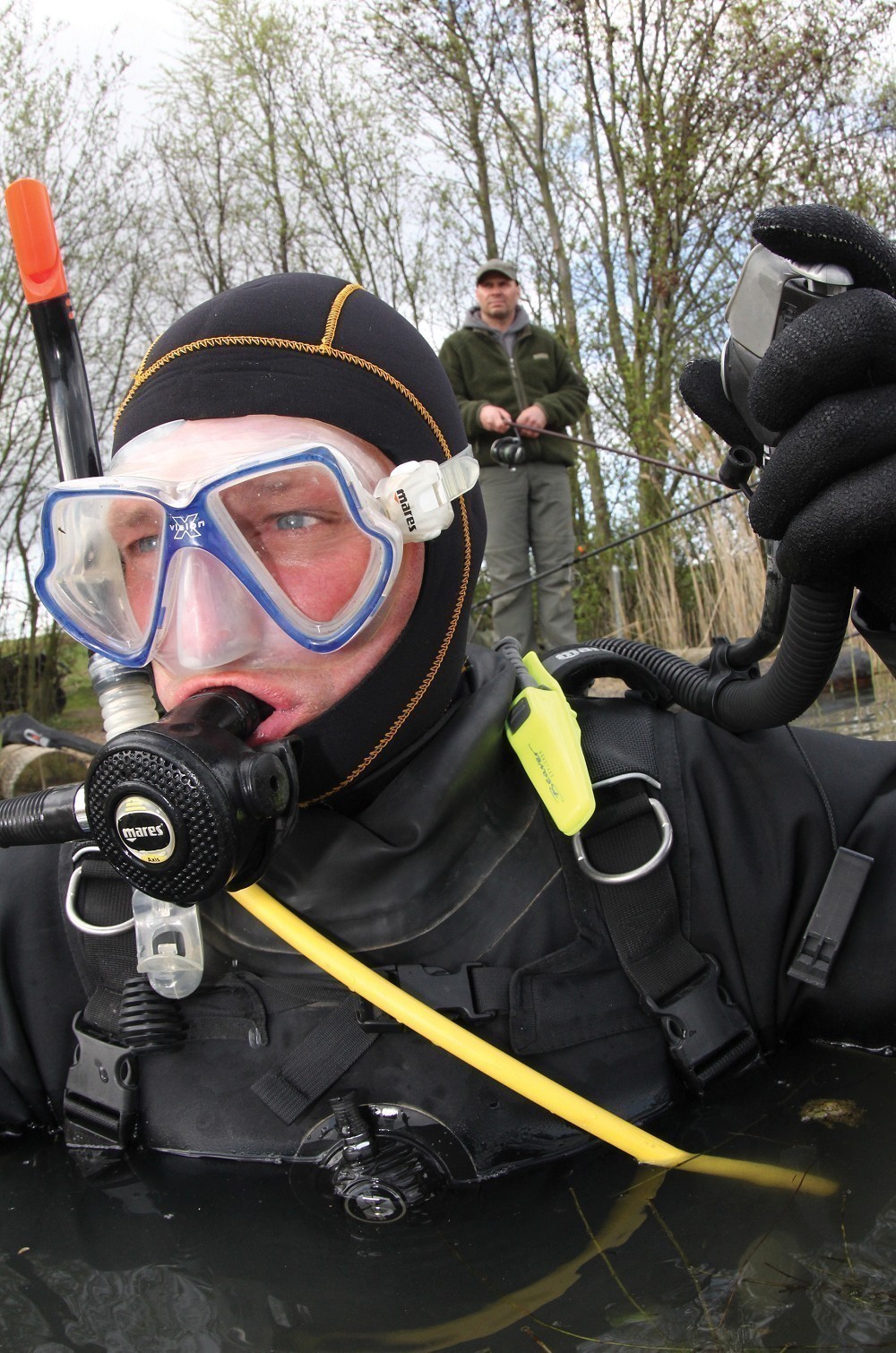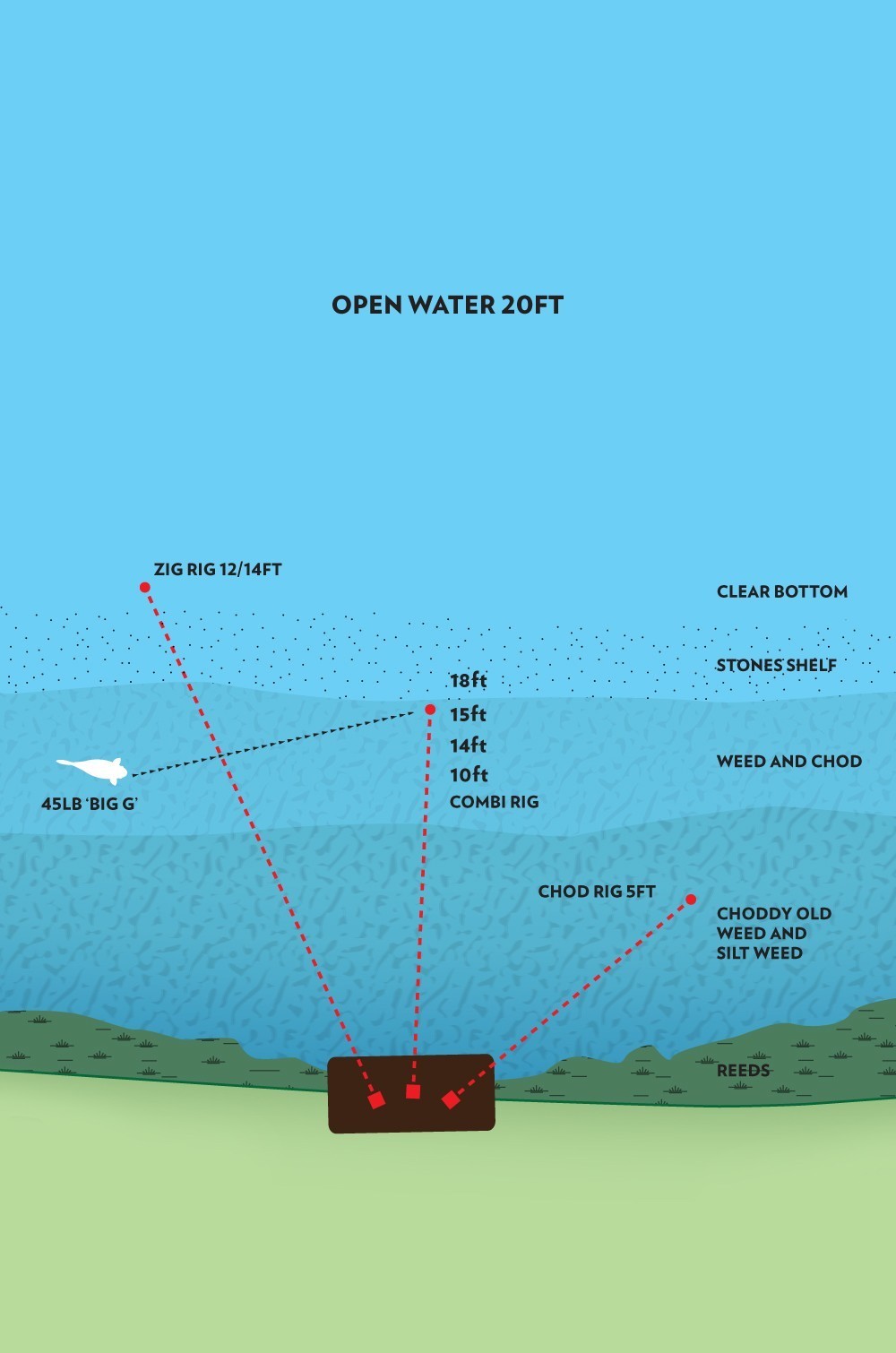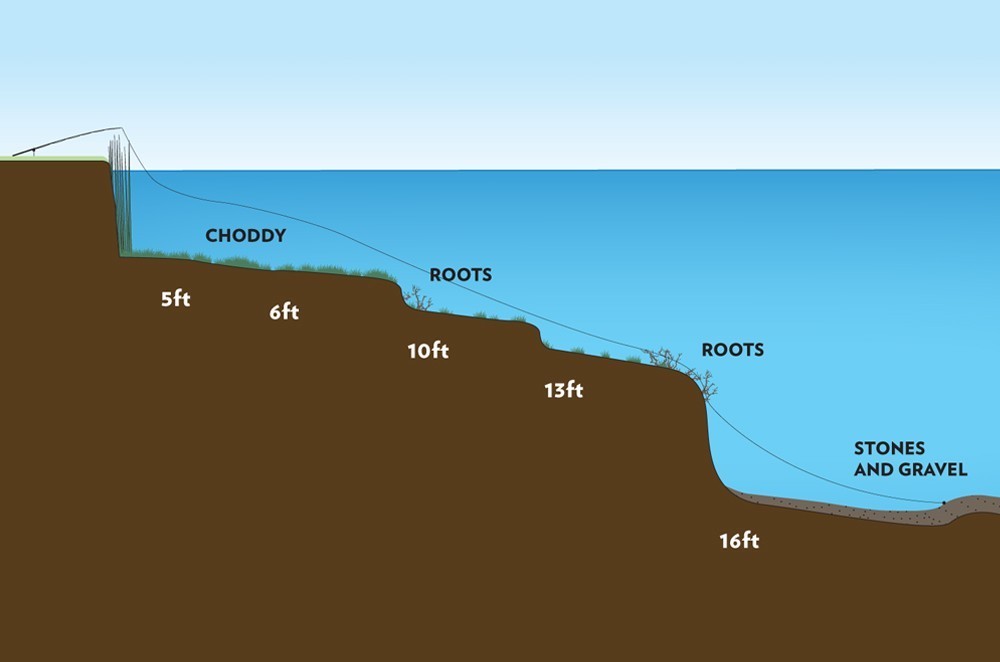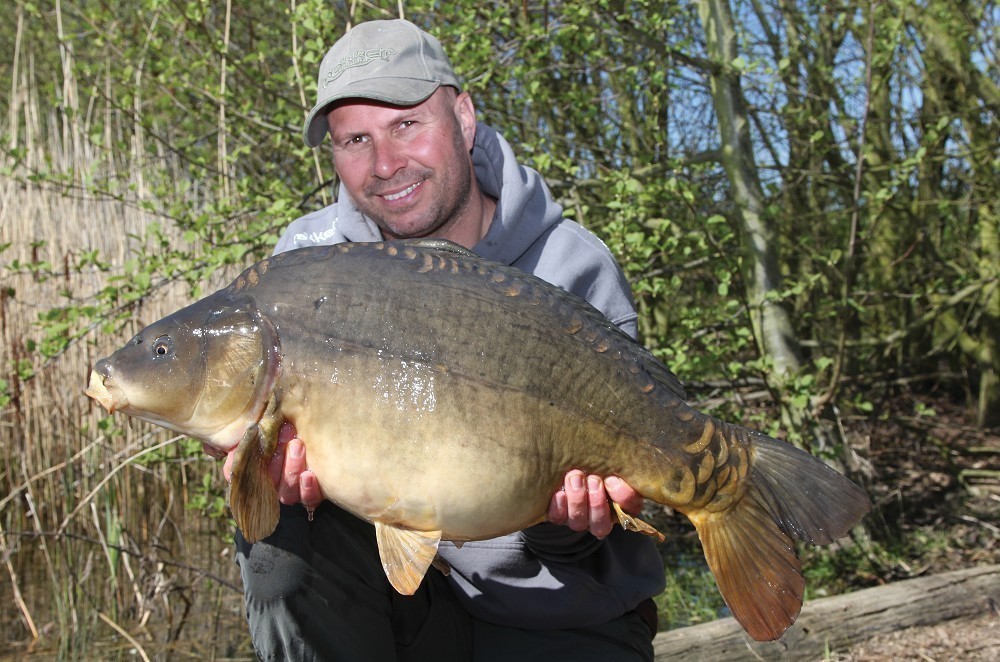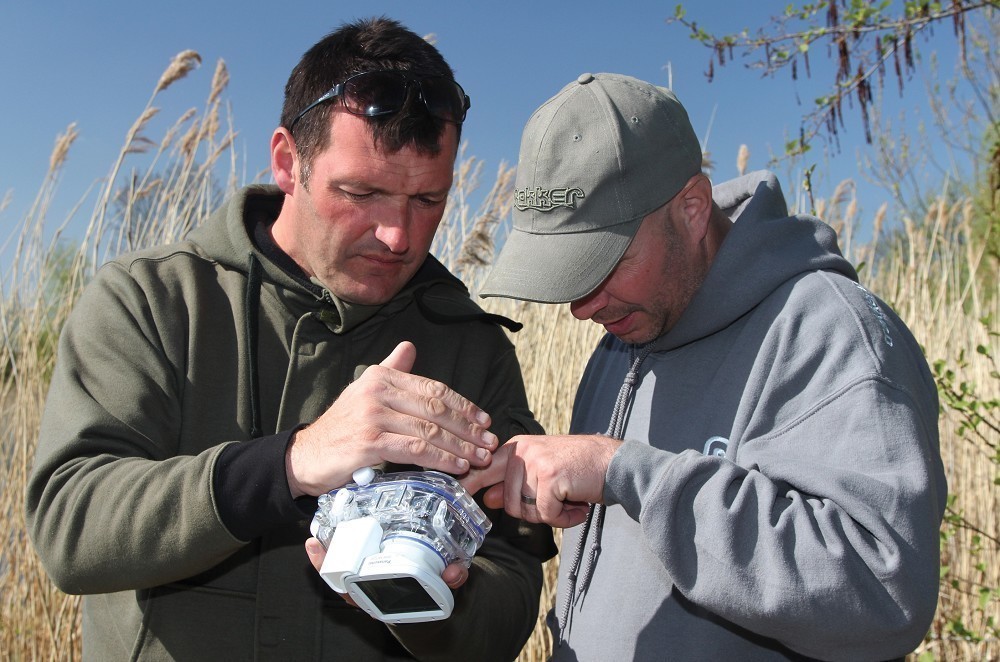Below the Surface: Dave Levy
''He's the angling equivalent of sonar''
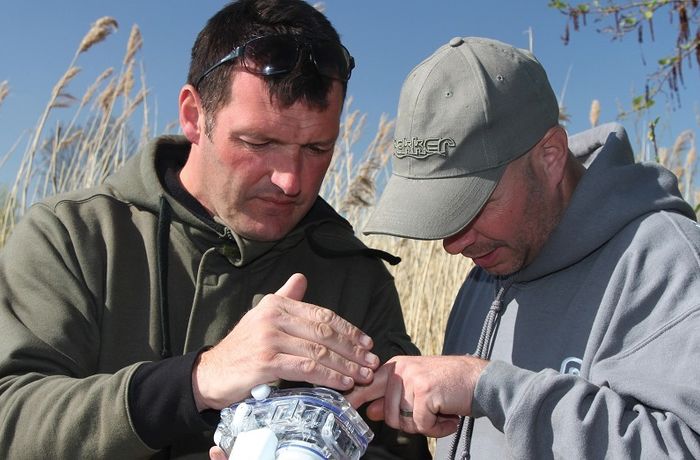
Here at CARPology we like to think of Below The Surface as being very similar to a fine wine: it simply gets better and better with age, because just when we think we’ve seen it all, we discover something new. The fact that we actually need to use the word ‘new’ so many times through these features really goes to show that we are still only scratching the (sub)-surface of what actually happens when we fish. These educational occurrences are often associated with our philosophy to keep exploring new waters, which has certainly been the case again this month, as we venture into Essex and onto the banks of Cleverley Fisheries for the first time to meet up with this month’s angling pro, Dave Levy. Having recently finished his campaign on Cleverley Mere in some style by catching his target fish ‘Hendrix’ at a little over 42lbs, we have arranged to join Dave on the neighbouring ‘Top Lake’, where Dave has his sights set on another big carp, hoping to add this forty-plus mirror to his already long and impressive list of UK captures.
Leaving the car park we are met with a rather chilly NE wind blowing into our face, but as we walk around the lake, roughly six-acres in area and shaped like an oval bell, it gradually becomes warmer. Although it’s not until we approach the opposite bank that we can fully appreciate the pleasant heat of a bright sun, high in the clear blue sky, with this sunshine amplifying our pleasing first impression of this lovely looking lake. With its margins surrounded by thick reedbeds and bankside trees filtering the breeze blowing across the open landscape of fields and hedgerows circling much of the venue. Now looking back across the lake towards the car park and roughly halfway down the west bank, we find Dave, as you’d expect any Ex-Paratrooper to be, and excitedly eager to crack-on. So Dave has already taken a look around the lake and decided to plot himself in a swim known as ‘The Snags’, sitting nicely behind the cold wind. Although it’s unapparent as to the derivative of the peg name, as there aren’t any visible snags to be seen within the swim that simply looks out onto the centre of the lake.
The reason why Dave has chosen this position becomes apparent as we begin to chat.
“When I got here the wind was blowing the way it is now,” remarks Dave, “it was cold, so I came around to the back of the wind to start looking for fish. Basically most of the carp in the lake were along here, including the forty down to the right of this swim, so I’ve come in here to get as close to them as possible.”
With the kettle on, Dave continues to talk about location, explaining that on other lakes ‘being on ‘em’ can be of paramount importance, but it’s not quite so important at this venue. In his experience the ‘Top Lake’ carp do like to follow the wind, but will then normally start to show before doing a lap of lake through the night. When faced with this scenario, Dave isn’t too fussed about how busy the lake may be or what swims are available. As long as he can find features within his swim that he feels will do a bite, he’s happy to work the swim he’s in and on that note, Dave reaches for his marker rod.
Using a conventional marker float set-up consisting of a Korda Drop Zone Marker Float at the end of a braid main line, running through a ring swivel, Dave begins to cast around his swim to find his features. An eight-inch mono boom is included between the swivel and the 3.5oz lead being used to, “keep the float out the crud” as Dave puts it, so it doesn’t get caught up in any weed.
“I know what I’m pulling over,” says Dave, “but I still want the float to be able to come up, so I can mark thick weed if I like, because you know the fish are going to want to hang around it.”
Between casts, Dave explains that he believes much of the lakebed to consist of clay with quite a few stone/gravel patches dotted around the lake. In some cases these gravel ledges can be quite nasty and sharp, especially on the opposite bank, before you come up onto the marginal shelf. Once in this shallower water you’ll find a lot of sediment from the rotting weed of last year.
Dave also points out that he likes to overcast his marker, so the disturbance of it hitting the water is beyond where he is likely to fish, as he continues to cover some of the other techniques he employ’s when using the marker rod.
“I like to draw the rod back upright rather than to one side because I think when your coming up the shelves it’s more sensitive and I can feel more. I don’t want the line laying over the corner of the shelf because I’m pulling it sideways. With the rod held upright it’s bringing the lead back upwards and giving me better sensitivity.” Looking across the lake we can see that our intrepid diver, Hughesy has now arrived as Dave makes his last few casts with the marker to his left where he has seen a fish show.
With the marker work complete, our pro sits back in his bivvy to prepare his rigs, but not before following one of his routine procedures. Taking a few Mainline boilies he squashes them in his hands. “I just like to do this to take away any non-carpy scent from my hands, before touching my rigs,” remarks Dave, as he rubs the boilies down to crumb in his hands, as if washing them in water. With the three rods being used, well prepared with terminal tackle and hookbaits, Dave begins to cast to his chosen spots next.
The intended destination for the left-hand rod is an area to the left of the swim at around fifty-yards, towards the shallower end of the lake. It’s an area where Dave has seen a fish show while setting up, but also an area where he believes he can intercept any fish leaving or attracted to the sunny shallows. Expecting these fish to be high in the water, Dave dispatches a Zig Rig to this spot. Having plumbed the depth at 14ft with the marker float, Dave has tied his small hookbait of black and red foam to a size 8 Choddy hook, as he feels the out-turned eye provides a better hooking angle from the mono hooklink, 11’ 6” in length.
“My reason for the having a light and dark coloured piece of foam on the Hair is so whatever colour is standing out best in the light, I’ve always got something working for me.”
Expecting his long hooklink to come straight up from the bottom, Dave also remarks that it will interesting to see if it’s actually at a slight angle, which he thinks could be a possibility.
“The foam hookbait should be around 3ft under the surface,” says Dave as he places the rod on its alarm. “I think this is a good depth for passing fish to see a small black dot in the water and think it’s a caddis fly or something and snatch at it. My other rods will be on the bottom, but I’m trying to give myself every opportunity of catching and with one on a Zig, I’m covering all bases,” states Dave, as he adds a light bobbin to his line and moves onto casting the middle rod.
The cast of a bare lead, follows one of the marker rod to pinpoint Dave’s chosen spot for his middle rod, which is again at around 50yds range, straight out from the swim. It’s a spot Dave has caught from before where he describes what he believes to be the topography of the bottom in great detail.
“There’s a gravel shelf out there that starts off being smooth even though it’s gravel in fourteen feet of water. Then you hit the stones and it’s still 14ft, before you come up gradually to 13ft. From 13ft, I probably only come back maybe half a rod length and it jumps up to 10ft. At this stage you start to hit the choddy stuff, weed and stuff like that, until you eventually come up onto the marginal shelf which is around 3-4ft deep and a lakebed of soft clay.”
After casting the bare lead and getting the correct drop onto the bottom, Dave clips-up his line on the reel and attaches his rig, ready to cast. Complete with a three-bait stringer that Dave calls ‘the forgotten art of PVA’ he decides on a fluorocarbon/braid Combi-Rig for this rod.
The Hybrid boilie used as the hookbait has been drilled out slightly to house a small cork insert used to create a ‘balanced’ hookbait. With this presentation cast to the spot, just onto the gravel in 10ft, Dave adds six catapult pouches of boilies.
“I not looking for a compact feeding area,” remarks Dave, as he twangs out another pouch of bait, “I want to make the fish work for the food and move between mouthfuls over a spread of bait. So I’ve not got that ‘on the spot’ feeding, where I think you tend to have the fish dropping the rig a lot.”
For the final rod, Dave again chooses a different presentation to the ones used already, by opting to cast a ‘Naked’ Chod Rig to his marker float positioned to the right of the swim and explains a cheeky little reason why.
“Although I normally use a Choddy on a leadcore leader, I’ve recently joined some waters where leadcore isn’t allowed, so I’m using the ‘Naked’ version here, because I want to find out how it looks and how it sits on the bottom.” The other reason for Dave’s choice of the Chod Rig is because he is looking to present a bait over the mix of fresh and dying weed on the shallower marginal shelf in around 5-6ft of water. An area where Dave saw the fish showing some interest earlier in the day.
Dave has set-up his pineapple pop-up on a Chod-link running on the main line between two 4mm rubber beads, each sat over a small Tungsten Sinker. The bottom bead is positioned 10-inches above the lead with the top bead set around 4ft above that, so the rig has some running room. After casting to the marker, Dave baits up with some chopped boilies which he believes will flutter slowly to the bottom to create a spread of bait where much of it settles on the pieces of weed rather than in it. So the free feed will hopefully be a few inches off the lakebed, just like the hookbait.
With his three traps set and Hughesy suiting up, preparing to dive, Dave talks about his line lay and expected bite indication.
“Having hit the clip nicely on all my final casts, I think my rigs will be lying nice and straight. The stringer on the middle rod will also help kick out that rig. It’s one of the reasons why I’m quite particular about how I hit the clip, where I need to hit the clip just prior to the rig hitting the water and not high in the air, which certainly leads to tangles. That’s one reason why I like to hold the rod to one side when I cast rather than centrally above my head and that’s so there’s nothing in the way when I’m watching the cast in flight. I also find it a very accurate method. When the lead hits the bottom, I’ll sink the rod tip and maintain a tight line as I sink it. After a few minutes I’ll attach my bobbin to the line still tight and then begin to play-off and slacken some line, so it doesn’t sink in a big heap, but will sink nice and straight onto the bottom.
“The two bottom rig rods will be fished with a slack line and because I don’t want to cut the marginal rod off with a tight line that I’d prefer on the Zig rod, I’ll fish that one with the line semi-slack. Indication-wise, I think if Rob tests the Zig he’ll probably be able to move it several feet, the Chod is a bit of an unknown quantity as it all depends in which direction Rob or a fish picks it up and moves. With the middle rod, I reckon there would only be two-feet of movement before I’d strike the rod.”
Right, over to Hughesy...
This season we have changed the way that we do things a little, as in previous years I have been present when our pro talks about what they are doing and what they think is down there. To add a little more spice I am now not allowed to listen, so neither of us knows what the other is going to say. This adds a little extra excitement when I come out of the water and we compare our notes and findings.
Rig 1: Choddy
Dave’s first rod, the Choddy off to the right of the swim was the first on my target list and like Jack Brown last month, Dave was ‘spread betting’ by fishing three rods in three different spots with three different tactics. This is generally how I fish and is much more interesting for me on a dive because we obviously get to look at three different approaches rather than just one.
The first thing that I noticed upon getting into the water was that it was holding a little bit of colour and was a lot warmer than my previous dive up in the Midlands only three days earlier. It was May when we went out with Dave. A time when the water is warming up and there was a significant difference between the water temperature in the south of the country in comparison with the north, so something to bear in mind for next year… The north-south divide definitely exists!
I finned out along the margins and it was weedy and dropped slowly off to the first step. Again, there was a load of new weed growth emerging to about a foot in length and I followed Dave’s line easily, noticing in the distance that the weed was clearing a little. I then noticed a few clumps of chopped boilies that had been Spombed and more or less in amongst them was his Choddy, sitting quite nicely in what I would class as the best area that I had seen so far. It was a clear clay bottomed area covered in a light dusting of silt amongst the emerging Canadian, and looked to me to be about the best spot in this part of the lake.
One of the things that I like to do is not just look at the spot itself, but also have a general scan round the area to see if there was somewhere that was slightly better that the angler could have put their baits. The answer on this occasion was that the spot he’d chosen was probably the best one in the swim on the right-hand side at this depth – a good start.
Even in the coloured water his line stood out quite a lot though, and because of the low-lying weed in the area was ever so slightly off the bottom. Not a problem in this situation as he was fishing a Choddy, which was as good a method as any to use on this spot due to the strand nature of the weed. There were a few tight clumps of bait, which I have to say were pretty accurate and on the whole the presentation looked to be a good one. The water was warm in this area, the spot was a good one and the presentation was good. Having dived a few times in the run up to this particular feature, all of the fish that I had seen were either in the margins or up in the water and when I got out of the lake I commented that I felt that this rod was a bite waiting to happen.
Rig 2: A combi set-up
Dave’s second (middle) rod was a slightly different matter. He was fishing in the deeper water at about thirteen-feet deep and as I finned out along the line from the margins it dropped down the first step onto a slowly dropping weed covered slope getting deeper and darker until saw in the murk ahead of me a fallen tree. It was a fair way out into the pond, impossible for me under the water to gauge exactly how far out but I would estimate at 40yds or so. The line raised up over one of the branches of the tree before dropping steeply to the second big step down.
The depth changed quite quickly over a distance of about six-feet and the whole atmosphere of the lake changed. It was noticeably darker and I had to adjust the camera setting to get a clear shot, but it was also a lot colder. It wasn’t as dramatic a change as the thermocline that we experienced in Bundy’s Pit a couple of years earlier, but it was noticeable. In fact, I would say the surface temperature was twelve- to fourteen-degrees and the change here went down to about eight. It was cold, the weed growth was slower, and the whole area felt very, very different to the first spot. It was quite eerie down there, as the bottom sloped off into the deepest part of the lake and to be honest felt dead. I remember being quite pleased to get out of the spot and head back up to the more comfortable, warmer water of the margins thinking that if he caught from that spot he would be lucky, as there seemed to be very little life down there. I can imagine that in the colder months it would be a good place to put a bait as the temperature would be fairly constant and the shelf offered some security for the fish. However, at this time of year it seemed to be more of a no-hoper until the sun had warmed the water a little more. Come the end of June after spawning it might be worth a shot again.
Line lay was good as the weed was not present in this deeper water, just the odd strand of filamentous algae and the slope meant that his line was close to the bottom and out of the way.
Bait-wise he had sticked out a few boilies in the general area and, being round and landing on a shelf, some had rolled away and others had grouped together. The baiting was light with just the odd one or two here and there, and where the hookbait was, it was quite silty, it being at the bottom of the pit. The hookbait itself was very hard to make out from the other baits and I couldn’t see the lead or hooklink at all as they had buried themselves in the silt. I could follow the line though and that pointed at a solitary bait on the silty bottom, and the only way I could make it out as different from the others was that I could see the Hair stop. The fish of course couldn’t so in all the presentation was a very good one, albeit that I felt it was in the wrong place because of the temperature difference. I would be surprised if anything went down there, let alone feed there as there were significantly more comfortable places to be in the lake.
Interestingly, and almost as if to prove my point, as I came back up out of the depths and got to about eight feet of water the weed increased and I stumbled across a carp that was sleeping in the weed. I don’t know who was most surprised, me or it, and I nearly jumped out of my dry suit when it shot off creating a big cloud of silt just a yard or so in front of me!
I’ll jump forwards a bit now before I come to the next rig to talk about what happened when I got out of the water. I was trying to explain to Dave how the bottom of the lake shelved down to a step then dropped to the snag before shelving off again to the abyss, and I decided to draw it. Cast your mind back to what I said earlier about not being present when the lads talk about their swim and presentation. I had no idea what he had written, and he didn’t know what I was going to draw, but when we put the two plans together they were almost identical, even to the extent that the degree of drop and also the width of step was the same. This was the most accurate reading of a tricky swim that I have ever come across and would actually say he’s a cartographer (Google it) rather than a carp angler he was that accurate! It’s easy to spot a gravel bar in a silt field, and easy to find a clump of weed in the clean area, but this was different gravy. Top marks indeed!
Rig 3: A Zig Rig
The last one to look at was the Zig and there isn’t a lot to say about what a Zig looks like underwater or indeed the positioning of it. The presentation looked good and held up well and was in my mind a possible for a bite. The black and red combo stands out well in the water and Zigs are a sight feeding method, so this one looked like it could do the business if the fish were patrolling just under the surface. It was about a foot down and was pretty static being underneath the gently moving surface water.
Day Two - Dive Two
We left Dave to his own devices for the evening having decided to stick with what he had done and there was no surprise in the morning when we had a call from him saying that he had caught one and that it had come from the right-hand side on the Chod. Nothing had occurred on the other two rods, so I rigged back up and decided to go and take a look at the Chod spot to see what had changed. We concentrated on this one as the Zig would look exactly the same and I was positive that the deep rod wouldn’t have changed.
One of the big myths in carp fishing is that the hookbait is always the last to go. We have proven on previous occasions that this is not the case and so it proved again with this one as I zoned in on the spot and saw there were still a fair amount of chops left uneaten. It was probably the case that a single or pair of fish had wandered along the shelf, seen the grub and tucked in for a snack, Dave bagging one in the process. On a clear bottom it’s not always best to fish a pop-up over the top of a bed of bait, but in an area like this it proved to be absolutely perfect. I’m not sure if our man had boosted his hookbait with anything but the carp had clearly homed in on it above the other baits because to my eyes there looked to hardly any that had been eaten.
Dave had re-cast, and knowing the spot from the previous days dive I could see that it was in an almost identical position on the clear area, so undoubtedly if he had been staying longer he would have been in with a chance of more bites.
The indication test
The last thing to look at would be the indication and for this I did the usual thing of picking up the hookbait and moving directly away from the rods. The Chod slid down to the weight slowly and I felt the indication after about a metre. It was little bit more than with a lead clip or helicopter as the Chod can slide along the line before the weight comes into play, but by then it’s usually hooked anyway.
In conclusion
In conclusion, my thoughts were that Dave had got it absolutely spot-on with the Chod set-up and so it was proved with the capture. As mentioned earlier, the line stood out a little bit too much for my liking, but that was a confidence thing as the fish clearly didn’t mind, and I think we can be fairly sure that the reason the deeper rod didn’t go was as a result of the colder water down there, something that Dave will no doubt log for the future.
The fact that he catches so many fish and also caught for us shows he has got what it takes, but for me the most impressive thing that must be repeated was his ability to read the swim in front of him and get it so right. If you want to know exactly what’s down there in the future, don’t get yourself an echo sounder or a marker float – get yourself a Levy! In fact, he was so good that from now on he should be known as Eagle!
What Dave learned...
“I really enjoyed doing this feature, it’s been a proper eye-opener. Like we’ve said, you think you know what your fishing over, but really it’s all a guess because it’s under the water. It’s not until you do something like this that you actually find out what’s going on, but when I saw the photos I was pleased because it reinforced what I thought was there, was actually there. The underwater tree really shocked me, as in how big it was; I knew it was there but thought it was only one- or two-feet across but it’s actually more like six-feet.
After looking at the features, I was glad I got the bottom shelf right – the steepness of it was what I was imagining. In October I was catching quite a lot of fish off of that. I don’t think the water has quite warmed-up enough for it yet, but it still gives me confidence that I’d got it right. So the one thing I’ll take away from this will be that my markering was accurate. We all think we’re good with a marker, but you don’t really know; I’m not saying I was brilliant, but I was pleased it was accurate and pleased that the night cast on the clip was in the right area as well. So yeah, I’m pleased and more confident.”





